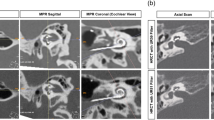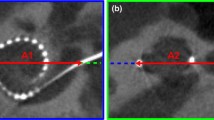Abstract
Objective
The aim of the present study is to evaluate the effect of electrode discrimination based on electrode to modiolus distance in different cochlear implant models, using image information to estimate the outcomes after an implantation on electrode discrimination
Methods
A descriptive prospective randomized study performed during 16 months. A psychoacoustic platform was used to evaluate patients’ electrode discrimination capabilities of patients. For the acquisition of the images, a cone beam computed tomography was used to assess postcochlear implantation of electrodes’ position. We considered two other new measurements: the intracochlear position index, which indicates how far is the electrode from the modiolar wall, and the homogeneity factor (HF), which provides us with information about the distance between the electrodes and the modiolus
Results
21 postlingually deaf adults showing different CI models [CI522 (n = 7), CI512 (n = 7), and CI532 (n = 7)] that corresponded to the lateral and perimodiolar array electrodes. The average success rate of the CI522 group was 47%, of the CI512 group was 48%, and of the CI532 group was 77%. There is statistically significant difference between groups CI532–CI522 (p = 0.0033) and CI532–CI512 (p = 0.0027)
Conclusion
The Nucleus CI532 offers a better perimodiolar placement. HF and IPI measurements provide information about the electrodes location inside the cochlea, being related to electrode discrimination.





Similar content being viewed by others
References
Saunders E, Cohen L, Aschendorff A, Shapiro W, Knight M, Stecker M, Laszig R (2002) Threshold, comfortable level and impedance changes as a function of electrode-modiolar distance. Ear Hear 23(1):28S-40S
McKay CM, O’Brien A, James CJ (1999) Effect of current level on electrode discrimination in electrical stimulation. Hear Res 136(1–2):159–164
Shepherd RK, Hatsushika S, Clark GM (1993) Electrical stimulation of the auditory nerve: the effect of electrode position on neural excitation. Hear Res 66(1):108–120
Pfingst BE, Holloway LA, Zwolan TA, Collins LM (1993) Effects of stimulus level on electrode-place discrimination in human subjects with cochlear implants. Hear Res 66(1):108–120
DeVries L, Scheperle R, Bierer JA (2016) Assessing the electrode-neuron interface with the electrically evoked compound action potential, electrode position, and behavioral thresholds. J Assoc Res Otolaryngol 17(3):237–252
Fu QJ, Nogaki G (2005) Noise susceptibility of cochlear implant users: the role of spectral resolution and smearing. J Assoc Res Otolaryngol 6(1):19–27
Finley CC, Skinner MW (2008) Role of electrode placement as a contributor to variability in cochlear implant outcomes. Otol Neurotol Off Publ Am Otol Soc Am Neurotol Soc Eur Acad Otol Neurotol 29(7):920
Boëx C, de BalthasarC, Kós, Pelizzone MI, M (2003) Electrical field interactions in different cochlear implant systems. J Acoust Soc Am 114(4 Pt 1):2049–2057
Bilger RC, Black FO, Hopkinson NT (1977) Research plan for evaluating subjects presently fitted with implanted auditory prostheses. Ann Otol Rhinol Laryngol 86(3 Pt 2 Suppl 38):21–24
Rebscher SJ, Hetherington A, Bonham B, Wardrop P, Whinney D. Leake PA (2008) Considerations for the design of future cochlear implant electrode arrays: electrode array stiffness, size and depth of insertion. J Rehabil Res Dev 45(5):731–747
Staller SJ, Beiter AL, Brimacombe JA, Mecklenburg DJ, Arndt P (1991) Pediatric performance with the nucleus 22-channel cochlearimplantsystem. Am J Otol 12(Suppl):126–136
Ebrahimi-Madiseh A, Eikelboom RH, Jayakody DM, Atlas MD (2016) Speech perception scores in cochlear implant recipients: an analysis of ceiling effects in the CUNY sentence test (Quiet) in post-lingually deafened cochlear implant recipients. Cochlear Implants Int 17(2):75–80. https://doi.org/10.1080/14670100.2015.1114220
Tykocinski M, Cohen LT, Pyman BC, RolandJr T, Treaba C, Palamara J, Cohen NL (2000) Comparison of electrode position in the human cochlea using various perimodiolar electrode arrays. Am J Otol 21(2):205–511
Macias AR, Morera C, Manrique M, Garcia-Ibanez L, Perez D, Caballe L, Estrada E (2007) Perimodiolar electrode position: effects on thresholds, comfort levels, impedance measurements, and neural response telemetry. Mediterr J Otol 3:140–149
Cushing SL, Daly MJ, Treaba CG, Chan H, Irish JC, Blaser S, Papsin BC (2012) High-resolution cone-beam computed tomography: a potential tool to improve atraumatic electrode design and position.Acta Otolaryngol 132(4):361–368. https://doi.org/10.3109/00016489.2011.644805
Holden LK, Finley CC, Firszt JB, Holden TA, Brenner C, Potts LG, Skinner MW (2013) Factors affecting open-set word recognition in adults with cochlear implants. Ear Hear 34(3):342–360. https://doi.org/10.1097/AUD.0b013e3182741aa7
Iso-Mustajärvi M, Matikka H, Risi F, Sipari S, Koski T, Willberg T, Dietz A (2017) A new slim modiolar electrode array for cochlear implantation: a radiological and histological study. Otol Neurotol 38(9):e327–e334
Xu J, Xu SA, Cohen LT, Clark GM (2000) Cochlear view: postoperative radiography for cochlear implantation. Am J Otol 21(1):49–56
Cohen LT, Xu J, Xu SA, Clark GM (1996) Improved and simplified methods for specifying positions of the electrode bands of a cochlear implant array. Am J Otol 17(6):859–865
Ketten DR, Skinner MW, Wang G, Vannier MW, Gates GA, Neely JG (1998) In vivo measures of cochlear length and insertion depth of nucleus cochlear implant electrode arrays. Ann Otol Rhinol Laryngol 175:1–16
Noble JH, Labadie RF, Gifford RH, Dawant BM (2013) Image-guidance enables new methods for customizing cochlear implant stimulation strategies. IEEE Trans Neural Syst Rehabil Eng 21(5):820–829. https://doi.org/10.1109/TNSRE.2013.2253333
Henry BA, McKay CM, McDermott HJ, Clark GM (2000) The relationship between speech perception and electrode discrimination in cochlear implantees. J Acoust Soc Am 108(3):1269–1280
Vickers D, Degun A, Canas A, Stainsby T, Vanpoucke F (2016) Deactivating cochlear implant electrodes based on pitch information for users of the ACE strategy. Adv Exp Med Biol 894:115–123
Cosentino S, Carlyon RP, Deeks JM, Parkinson W, Bierer JA (2016) Rate discrimination, gap detection and ranking of temporal pitch in cochlear implant users. J Assoc Res Otolaryngol 17(4):371–382
Zaballos MP, de Miguel AR, Killian M, Macías AR (2016) A Psychophysics experimental software to evaluateelectrical pitch discrimination in Nucleuscochlearimplantedpatients. J Phys Conf Ser 689(1):012030 (IOP Publishing)
Zwolan TA, Collins LM, Wakefield GH (1997) Electrode discrimination and speech recognition in postlingually deafened adult cochlear implant subjects. J Acoust Soc Am 102(6):3673–3685
Marx M, Risi F, Escudé B, Durmo I, James C, Lauwers F, Fraysse B (2014) Reliability of cone beam computed tomography in scalar localization of the electrode array: a radio histological study. Eur Arch Otorhinolaryngol 71(4):673–679. https://doi.org/10.1007/s00405-013-2448-6
Saeed SR, Selvadurai D, Beale T, Biggs N, Murray B, Gibson P, Boyd P (2014) The use of cone-beam computed tomography to determine cochlear implant electrode position in human temporal bones. Otol Neurotol 35(8):1338–1344. https://doi.org/10.1097/MAO.0000000000000295
Lathuillière M, Merklen F, Piron JP, Sicard M, Villemus F, de Champfleur NM, Mondain M (2017) Cone-beam computed tomography in children with cochlear implants: the effect of electrode array position on ECAP. Int J Pediatr Otorhinolaryngol 92:27–31. https://doi.org/10.1016/j.ijporl.2016.10.033
Dahmani-Causse M, Marx M, Deguine O, Fraysse B, Lepage B, Escudé B (2011) Morphologic examination of the temporal bone by cone beam computed tomography: comparison with multislice helical computed tomography. Eur Ann Otorhinolaryngol Head Neck Dis 128(5):230–235. https://doi.org/10.1016/j.anorl.2011.02.016
Ruivo J, Mermuys K, Bacher K, Kuhweide R, Offeciers E, Casselman JW (2009) Cone beam computed tomography, a low-dose imaging technique in the postoperative assessment of cochlear implantation. Otol Neurotol 30(3):299–303. https://doi.org/10.1097/MAO.0b013e31819679f9.
Hodez C, Griffaton-Taillandier C, Bensimon I (2011) Cone-beam imaging: applications in ENT. Eur Ann Otorhinolaryngol Head Neck Dis 128(2):65–78. https://doi.org/10.1016/j.anorl.2010.10.008
Pfingst BE, Burkholder-Juhasz RA, Zwolan TA, Xu L (2008) Psychophysical assessment of stimulation sites in auditory prosthesis electrode arrays. Hear Res 242(1–2):172–183. https://doi.org/10.1016/j.heares.2007.11.007
Skinner MW, Holden TA, Whiting BR, Voie AH, Brunsden B, Neely JG, Finley CC (2007) In vivo estimates of the position of advanced bionics electrode arrays in the human cochlea. Ann Otol Rhinol Laryngol 197:2–24
Polonenko MJ, Cushing SL, Gordon KA, Allemang B, Jewell S, Papsin BC (2016) Stimulation parameters differ between current anti-modiolar and peri-modiolar electrode arrays implanted within the same child. J Laryngol Otol 130(11):1007–1021
Funding
This study was not funded.
Author information
Authors and Affiliations
Corresponding author
Ethics declarations
Conflict of interest
The Nucleus Interface Communicator (NIC) toolbox was provided by Cochlear AG for this study. No other conflict of interest or funding was used for this study.
Ethical approval
All procedures performed in studies involving human participants were in accordance with the ethical standards of the institutional and/or national research committee and with the 1964 Helsinki declaration and its later amendments or comparable ethical standards.
Rights and permissions
About this article
Cite this article
Ramos de Miguel, Á., Argudo, A.A., Borkoski Barreiro, S.A. et al. Imaging evaluation of electrode placement and effect on electrode discrimination on different cochlear implant electrode arrays. Eur Arch Otorhinolaryngol 275, 1385–1394 (2018). https://doi.org/10.1007/s00405-018-4943-2
Received:
Accepted:
Published:
Issue Date:
DOI: https://doi.org/10.1007/s00405-018-4943-2




